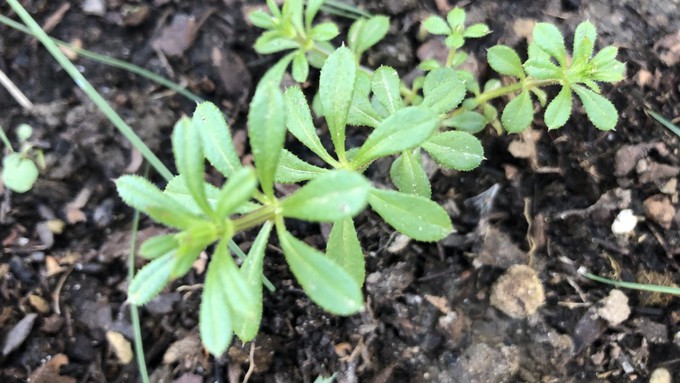
Enjoy a glimpse of spring before more rain arrives

This is bedstraw, an obnoxious, sticky weed that gets worse the bigger it gets. Dig it out now while it’s small. Kathy Morrison
According to the National Weather Service, Sacramento has a 40% chance of rain showers on Monday morning, then “likely” to “definite rain” on Thursday night and Friday.
For most of Sacramento, the first storm will offer light rain if any. The weather service expects less than 0.1 inches. But the later storm could deliver a half inch or more of precipitation.
After our sunny break with temperatures nudging near 70, we’ll be back in the low 60s for the next several days. Nights will be chilly. With clear skies between storms, overnight lows on Tuesday and Wednesday will dip to about 40 degrees.
Make the most of clear days and get to work! The real spring will be here soon.
* Fertilize roses, annual flowers and berries as spring growth begins to appear.
* If aphids are attracted to new growth, knock them off with a strong spray of water or insecticidal soap. To make your own “bug soap,” use 2 tablespoons of liquid soap – not detergent – to one quart of water in a spray bottle. Shake it up before use. Among the liquid soaps that seem most effective are Dr. Bronner’s Pure-Castile Soaps; try the peppermint scent.
* Pull weeds now! Don’t let them get started. Take a hoe and whack them as soon as they sprout.
* Start preparing vegetable beds. Spade in compost and other amendments.
* Prune and fertilize spring-flowering shrubs after bloom.
*Feed camellias at the end of their bloom cycle. Pick up browned and fallen flowers to help corral blossom blight.
* Prune and fertilize spring-flowering shrubs and trees after they bloom. Try using well-composted manure, spread 1-inch thick under the tree. This serves as both fertilizer and mulch, retaining moisture while cutting down on weeds.
* Cut back and fertilize perennial herbs to encourage new growth.
* In the vegetable garden, transplant lettuce and cole family plants, such as cabbage, broccoli, collards and kale.
* Seed chard and beets directly into the ground.
* Before the mercury starts inching upward, this is your last chance to plant such annuals as pansies, violas and primroses.
* Plant summer bulbs, including gladiolus, tuberous begonias and callas. Also plant dahlia tubers.
* Shop for perennials. Many varieties are available in local nurseries and at plant events. They can be transplanted now while the weather remains relatively cool.
Comments
0 comments have been posted.Sacramento Digs Gardening to your inbox.
Sites We Like
Garden Checklist for week of July 21
Your garden needs you!
* Keep your vegetable garden watered, mulched and weeded. Water before 8 a.m. to reduce the chance of fungal infection and to conserve moisture.
* Feed vegetable plants bone meal, rock phosphate or other fertilizers high in phosphate to stimulate more blooms and fruiting. (But wait until daily high temperatures drop out of the 100s.)
* Don’t let tomatoes wilt or dry out completely. Give tomatoes a deep watering two to three times a week.
* Harvest vegetables promptly to encourage plants to produce more. Squash especially tends to grow rapidly in hot weather. Keep an eye on zucchini.
* Pinch back chrysanthemums for bushy plants and more flowers in September.
* Remove spent flowers from roses, daylilies and other bloomers as they finish flowering.
* Pinch off blooms from basil so the plant will grow more leaves.
* Cut back lavender after flowering to promote a second bloom.
* It's not too late to add a splash of color. Plant petunias, snapdragons, zinnias and marigolds.
* From seed, plant corn, pumpkins, radishes, winter squash and sunflowers.